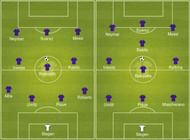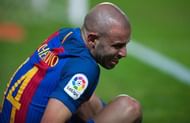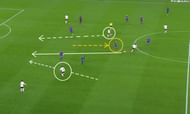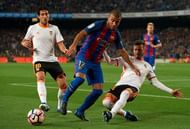Barcelona’s 4-2 victory over Valencia on Sunday night was anything but routine. It pulled them up to within two points of La Liga leaders Real Madrid (who have a game in hand) but the frailties of Luis Enrique’s surprise 3-3-1-3 formation were exposed by a struggling team who have less than half the points as the Catalan club.
Valencia are 14th in the table and have won only once in their last five league games. Yet, they looked like a side genuinely looking to challenge for Champions League spots – at least in the first half when they still had 11 men on the pitch. Eliaquim Mangala’s red card put Barcelona in the driving seat but not before Valencia threatened to take the game away from them on a number of occasions.
While watching Lionel Messi in full flow is always an awe-inspiring sight, it was more or less expected against 10 men. He put in a man of the match performance and also grabbed his 100th brace for Barcelona in the process. But all was not right for Enrique’s side on the night.
Also read: Barcelona 4-2 Valencia – 5 Talking Points
Barcelona are exposed with a back-three
Enrique has experimented with three defenders at the back in quite a few games this season. However, in most cases, it was a 3-4-3 formation with one spare full-back acting as a winger on one of the flanks to drop back when needed. But in the 3-3-1-3 formation, the lack of defensive stability almost proved to be their undoing.
One of the biggest games where Enrique opted for three at the back was in the all-or-nothing encounter against Paris Saint-Germain in the Champions League. Trailing 4-0 from the first leg, Barcelona had no choice but to go all out in attack to reduce the deficit. We all know what happened next; that insane comeback is now part of Camp Nou legend and the fairy tale will be recounted for generations to come.
However, in that game, Enrique had gone with an unorthodox 3-1-4-2 formation – one that Barcelona had never used this season. The early goal helped Barcelona produce the kind of performance that was required but the cause was also helped by a visibly terrified PSG squad who simply failed to turn up on what was supposed to be their biggest night in Champions League history.
That is not to say that PSG were utterly hopeless. They did create chances and were unlucky to see some go wide or come off the woodwork. It was the counter-attacks that saw PSG thrive in the few moments they had the ball and space to run into and it had a lot to do with Barcelona's high-line that saw Samuel Umtiti, Gerard Pique, and Javier Mascherano pushing up to effectively box PSG into their own half and force mistakes.
But in the 3-3-1-3 formation, Barcelona were without any real width. It is not the ideal way to play at the Camp Nou where the width of the pitch and a narrow formation requires players to constantly stay on their toes to cover a lot more space than usual when they press the opponents.
“In this system we are more exposed defensively. We need to know how to find the necessary balance between defence and attack.” – Samuel Umtiti after the Valencia game
The other aspect of the formation that did not work in Barcelona’s favour in the first half was the selection of players in wide areas with a lack of defensive nous. Enrique deployed Andres Iniesta on the left while Rafinha played on the right. Iniesta is best used with full-backs to cover him. Meanwhile, Rafinha is a hard working player but his positioning is not the best.
Javier Mascherano is the weakest link in a back-three
In the game against PSG, one thing that was clearly evident was the number of attacks the French side mounted on their left flank – Barcelona’s right. It was where Edinson Cavani’s goal came from apart from two other clear opportunities to score.
Angel Di Maria had the best chance to put the game to bed and almost did with a second away goal before he skied it over the bar. Shouts for a penalty after Mascherano felled him in the box fell on deaf ears but the contact came after the shot anyway. But Mascherano looked a relieved man and even admitted after the game that it probably should have been a penalty.
Against Valencia, it was actually Mascherano’s half-hearted and hesitant attempt to stop them in their tracks that allowed the away side to equalise just before half-time. It must be said that he was only partially culpable, though. As Mascherano stepped up into no man’s land in the absence of any Barcelona midfielder, Jose Gaya took the opportunity to accelerate into the void left behind to receive the through ball before he teed up Munir El Haddadi for a neat finish.
The Argentine defensive midfielder turned defender turns 33 this year and it is time Barcelona looked to replace him in the back line. Without a right-back or midfielder ahead of him, he is easily exposed and does come second-best in one-on-one duels.
Right-midfield is a problem Barcelona need to tackle
While Iniesta keeps the game ticking on the left of Sergio Busquets, the right side of midfield can see less of the ball. Although Lionel Messi technically starts on the right, his propensity to move to the centre means that most of the play is concentrated on the left or through the middle.
The left side sees the most action with 37% of Barca's attacks coming through that channel. In the traditional 4-3-3, Ivan Rakitic gets the job done (although not as much as he did last season) but when he is moved to the centre in the 3-3-1-3, players such as Rafinha and Sergi Roberto are not up to the task.
This is a major issue for Barcelona because when the focus is on the trio of Messi-Suarez-Neymar, it is the midfielders who see a lot more of the ball. While Iniesta is expected to do what he does best by carving openings on the left, the same cannot be said for the right side of Barcelona’s midfield.
The way forward?
While Barcelona do score goals aplenty thanks to the freedom afforded to MSN, the results have not shown that a back three is a viable option in the league because they leak goals. Switching to a back-three is ideal when they desperately need a result in knockout encounters. Against Valencia, Enrique took a gamble and it almost backfired if not for the red card to Mangala.
If Barcelona are to advance in the Champions League (and keep their hopes for another treble alive), this is not a formation Enrique should deploy against Max Allegri’s Juventus. The Italian manager is a master tactician and has used several formations this season – the most common being the 3-5-2 and 4-2-3-1. Both formations use wide players such as Dani Alves or Juan Cuadrado who can wreak havoc on the flanks.
The 3-3-1-3 formation is not ideal for Barcelona with the personnel they have – both in defence and attack. It should be an option Enrique should use as a last resort and he would do well to use it sparingly.





